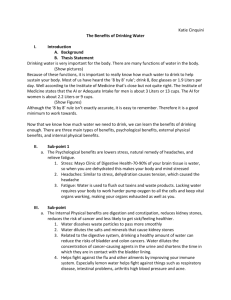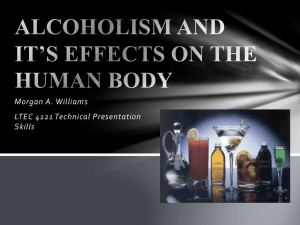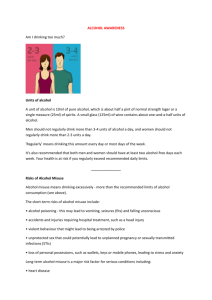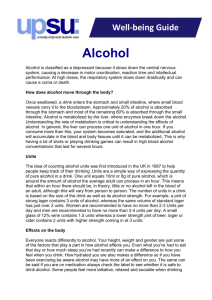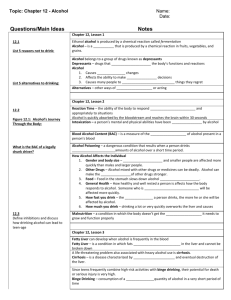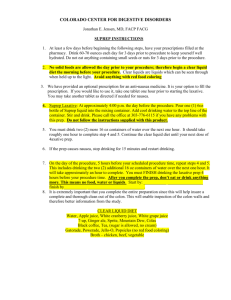He Drinks, She Drinks
advertisement
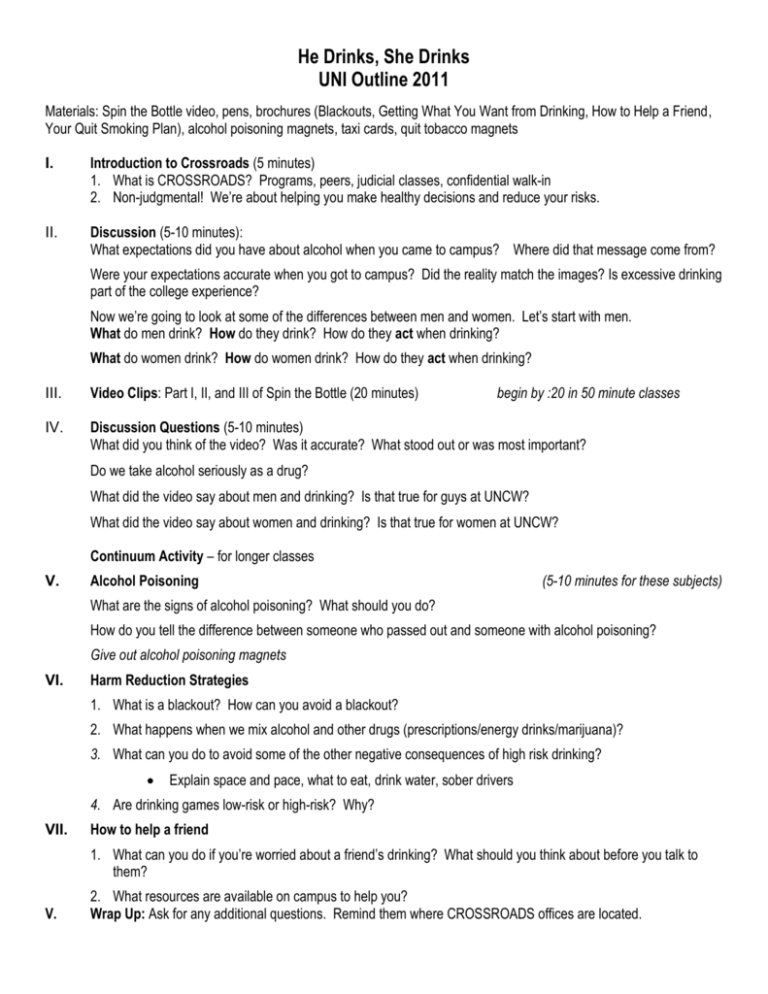
He Drinks, She Drinks UNI Outline 2011 Materials: Spin the Bottle video, pens, brochures (Blackouts, Getting What You Want from Drinking, How to Help a Friend, Your Quit Smoking Plan), alcohol poisoning magnets, taxi cards, quit tobacco magnets I. Introduction to Crossroads (5 minutes) 1. What is CROSSROADS? Programs, peers, judicial classes, confidential walk-in 2. Non-judgmental! We’re about helping you make healthy decisions and reduce your risks. II. Discussion (5-10 minutes): What expectations did you have about alcohol when you came to campus? Where did that message come from? Were your expectations accurate when you got to campus? Did the reality match the images? Is excessive drinking part of the college experience? Now we’re going to look at some of the differences between men and women. Let’s start with men. What do men drink? How do they drink? How do they act when drinking? What do women drink? How do women drink? How do they act when drinking? III. Video Clips: Part I, II, and III of Spin the Bottle (20 minutes) begin by :20 in 50 minute classes IV. Discussion Questions (5-10 minutes) What did you think of the video? Was it accurate? What stood out or was most important? Do we take alcohol seriously as a drug? What did the video say about men and drinking? Is that true for guys at UNCW? What did the video say about women and drinking? Is that true for women at UNCW? Continuum Activity – for longer classes V. Alcohol Poisoning (5-10 minutes for these subjects) What are the signs of alcohol poisoning? What should you do? How do you tell the difference between someone who passed out and someone with alcohol poisoning? Give out alcohol poisoning magnets VI. Harm Reduction Strategies 1. What is a blackout? How can you avoid a blackout? 2. What happens when we mix alcohol and other drugs (prescriptions/energy drinks/marijuana)? 3. What can you do to avoid some of the other negative consequences of high risk drinking? Explain space and pace, what to eat, drink water, sober drivers 4. Are drinking games low-risk or high-risk? Why? VII. How to help a friend 1. What can you do if you’re worried about a friend’s drinking? What should you think about before you talk to them? V. 2. What resources are available on campus to help you? Wrap Up: Ask for any additional questions. Remind them where CROSSROADS offices are located. Continuum Activity (for longer classes) 1. The best food to eat before drinking is bread or pasta MYTH! Anything is better than nothing, but protein stays in your stomach longer 2. Drinking water between drinks will kill your buzz MYTH! Space and pace helps your body catch up, water helps with dehydration 3. Over 20% of UNCW students don’t drink. TRUE! 21.5% don’t drink, about 30% didn’t drink in the last week, and 76% have 0-5 drinks 4. Playing drinking games reduces your risk of consequences MYTH! What are some of the risks? How can you lower the risk? 5. If my designated driver has 5 shots at 10pm, he will be sober to drive me home at 1am MYTH! 1 drink = 60 minutes, 5 shots at 10pm = 3am, will he stop at 5 shots? SafeRides 6. Mixing energy drinks and alcohol will make a hangover worse. TRUE! Both are dehydrating. What other risks are involved with mixing these? 7. Someone with alcohol poisoning will always throw up. MYTH – they usually do, but not always. What are the signs of alcohol poisoning? What should you do? How do you tell the difference between someone who passed out and someone with alcohol poisoning? 8. You cannot tell if a friend is experiencing a blackout TRUE! A blackout = memory loss, can’t tell until the next day. How can you avoid a blackout? 9. The best time to talk to a friend about their drinking is when they have a hangover False! The alcohol is still impairing their brain. What can you do if you’re worried about a friend’s drinking? What should you think about before you talk to them? What resources are available on campus? Presenter’s Cheat Sheet CROSSROADS 2 locations: Westside Hall 2nd floor and Student Recreation Center www.uncw.edu/crossroads 962-4136 Services include: campus programs and events, presentations to classes and student groups, peer education groups, student employment, volunteer and internship opportunities, confidential walk-in consultations and referrals, Challenging Decisions classes for on-campus alcohol and drug violations, help with class projects and questions about alcohol and drugs Alcohol Poisoning Signs: unconscious/unable to wake up, cool or clammy skin, slow and/or shallow breathing, slow heart rate, vomiting, incoherent, nails or lips may look blue or purple What to do: Never leave the person alone! Roll them on their side to prevent choking, check their breathing every 20 minutes, call 911 or take them to the hospital. Harm Reduction Strategies Blackouts: person has loss of memory but still awake and making decisions (to drink more, drive, have sex, get in a fight) triggers include quickly raising BAC from 0 to around .2 and fatigue, drinking on an empty stomach, high tolerance Mixing alcohol and other drugs: combined effect is worse than either alone Alcohol + stimulant (Ritalin, energy drinks) = masks drunk feelings, high-energy impaired decisions, extra hangover Alcohol + depressant (Vicodin, Xanax) = increased risk of alcohol poisoning Strategies: Space & Pace = space your drinks out by alternating alcohol and non-alcohol, pace yourself by not drinking quickly Be hydrated: drink lots of water, be careful when you’ve been in the sun/heat all day What to eat before you drink? anything is better than nothing, protein stays in your stomach longer Have a sober ride home – a DD you can trust, SafeRides, a backup plan, 1 drink = 60 minutes Risks of Drinking games hard to keep track of how many you’ve had drink too quickly – past your “limit” before you feel the first one pressure to keep drinking even after you’ve had enough sharing germs by sharing cups/ping pong balls/etc How to Help a Friend Do: talk to them, tell them examples, say “I feel…”, listen to their response, offer resources, offer to go with them, get help for yourself from the Counseling Center or CROSSROADS. Don’t: confront them when they’re drinking, judge them, say “You always…”, give ultimatums, avoid confronting them because you drink too Campus Norms: 74% of freshmen do not smoke 75% of UNCW students prefer to socialize in a non-smoking environment Most UNCW students have 0-5 drinks when the party (20% have 0) Most UNCW students drink 2 nights per week or less


